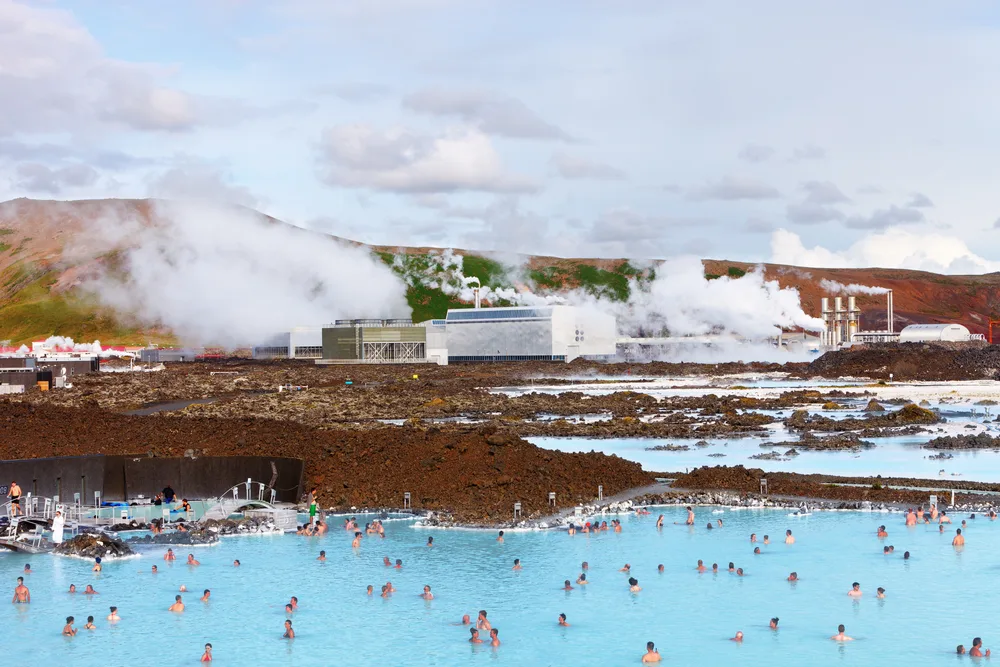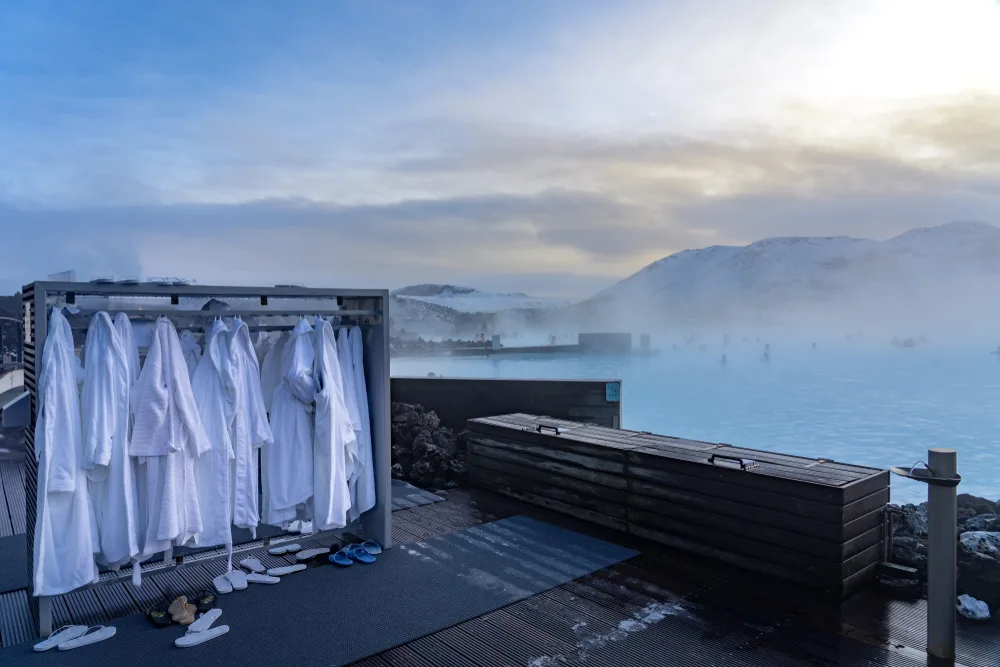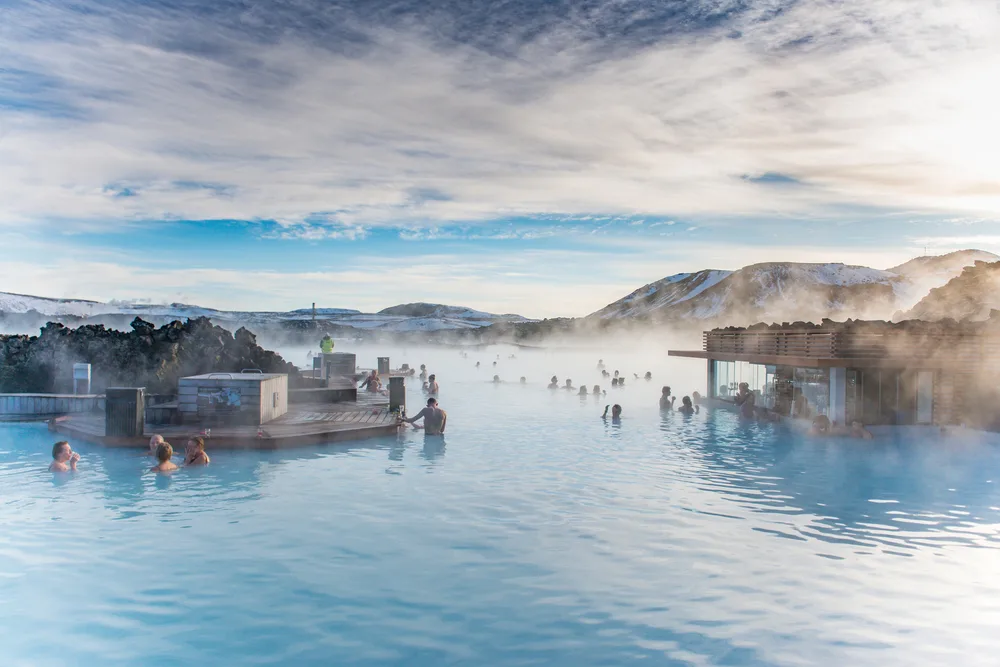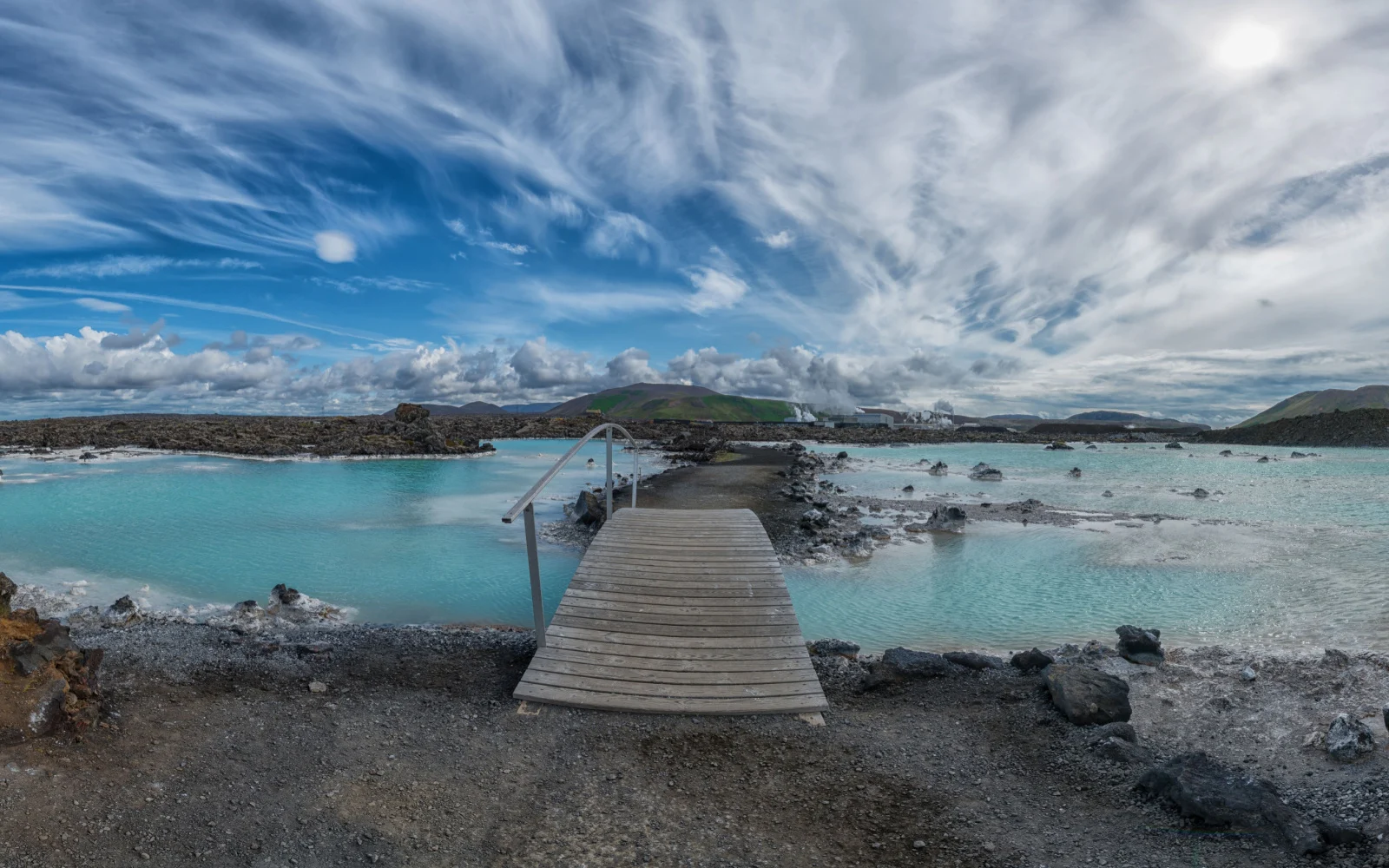Iceland’s Blue Lagoon is one of the country’s most popular tourist attractions. Every year, about 700,000 people visit the lagoon, a number that is twice the full-time population of Iceland.
People visit this popular destination because of its stunning appearance — there are few places in the world that have such stunning light blue water, and the views from the lagoon of the surrounding mountains are amazing.
The volcanic waters of the lagoon are always warm, even in the middle of Iceland’s winters.
Plus, the water and silica mud are said to have helpful properties for your health and appearance, making the Lagoon’s spa treatments very popular. However, before booking such an attraction, it’s a good idea to research practical concerns such as safety.
The Blue Lagoon is a bit pricey, so you definitely want to know what you are getting into before you commit to tickets. Read on to learn all you need to know!
Is the Blue Lagoon Safe to Visit in 2025?

Blue Lagoon, Iceland – August 02, 2014: People bathing in The Blue Lagoon, a geothermal bath resort in the south of Iceland, a ‘must see’ by tourists, near Reykjavik. August 02, 2014 in Iceland/Jose Arcos Aguilar/Shutterstock
Yes. The Blue Lagoon, like all of Iceland, is safe to visit. Crime in the area is very rare, even though a lot of tourists pass through.
The lagoon is well-maintained and swimming there is safe, although you should be careful as some parts of the experience are very different from swimming at your local pool.
To get an idea of the safety of the Blue Lagoon, it’s a good idea to check out the safety of the country it’s located in, Iceland. The good news is that Iceland is a very safe country.
It experiences few deadly natural disasters (besides its standard cold weather), very little civil unrest, and very low rates of crime. Most countries, such as Canada, only issue a Level One travel advisory for Iceland.
As long as you exercise basic precautions anywhere that you visit in the country, such as the Blue Lagoon, then you should have a safe time. Of course, problems can occur anywhere in the world, including the Blue Lagoon.
Visitors have complained about petty incidents such as:
- Pickpocketing
- Petty theft
- Theft of items from lockers
- Theft of items by the pool
Most of these incidents are petty, and the Blue Lagoon supervisors are doing their best to manage any problems that might arise.
There are a few things that you should know before you head out about how to swim safely. The Blue Lagoon is a man-made pool that actually was formed from the waste of a geothermal power plant.
The swimming area was built with safety in mind, and the water is switched out every 48 hours, making the lagoon cleaner than many other pools or hot tubs around the world.
The Blue Lagoon publishes safety rules on its website that you should read ahead of time to know how to stay safe. Babies are not allowed in the lagoon, and young children must wear floating armbands to stay safe.
Guests have a limit to how many alcoholic beverages they can consume and risky behavior such as running is not allowed.
The natural features of the Blue Lagoon, such as the mineral balance, are very particular and guests are asked to take precautions to protect this environment. Stick to marked paths around the lagoon to protect the volcanic landscape.
Guests are supposed to shower with special shower gel before and after getting into the lagoon to protect the minerals from any dirt they naturally have on their bodies.
The special mineral composition isn’t dangerous, but it can cause some unwanted consequences. Previous visitors have complained about the effect on their hair and bathing suits as the mineral salts are very difficult to wash out.
Make sure that you don’t submerge your hair if you’re not ready for the problems afterwards. If you have an expensive bathing suit, you can rent a cheap one from the Blue Lagoon.
Crime in the Blue Lagoon

berni0004/Shutterstock
It’s difficult to find accurate crime statistics for the Blue Lagoon as local authorities don’t keep crime statistics for individual tourist attractions.
However, by looking at crime statistics for the nearby capital of Reykjavik, you can get an idea of what crime is like in the lagoon. Reykjavik has a very low crime rate and is probably one of the safest capital cities in the world.
According to Numbeo, the crime index score of Reykjavik is 17.59 out of 100, which is a very low value. Residents reported some concern about drug abuse and petty property crimes such as vandalism and theft, but even these crimes occur fairly rarely.
The violent crime rate in Reykjavik, and all of Iceland, is very low. According to World Bank data, the homicide rate in Iceland is just 1.47 incidents per 100,000 people.
Other violent incidents are also very, very rare. This crime data about the city of Reykjavik and the country of Iceland as a whole can tell us a lot about the possibility of crime in the Blue Lagoon.
The risk of serious crime in the Blue Lagoon is practically non-existent. If you do encounter a crime, it is likely to be some form of petty theft.
Although statistics about crime in the Blue Lagoon are hard to find, anecdotal evidence can help you gauge how safe a trip to the Lagoon is right now.
Look at forums and third-party sites such as TripAdvisor, where travelers post about problems that they encountered while at the lagoon. This can help you prepare for what you might encounter when you visit.
Theft by the Poolside
Anecdotal evidence from previous visitors lists a few common problems they encountered at the Blue Lagoon. One of the most common was the theft of possessions by the side of the pool.
While visitors are swimming, other guests are on the lookout for items that they steal. The lagoon itself advises people to leave their possessions in assigned lockers.
That is the best way to protect your items from theft, as you can’t keep a good eye on them while you are in the pool. Plus, you don’t want valuable jewelry or other items to get damaged from the mineral steam coming off of the pool.
Most visitors follow this advice, but you still have to take certain items with you to the side of the pool such as robes, towels, and slippers for walking around the area.
Robes and slippers are complementary when you pay for an upgraded package that includes spa visits. Guests with the basic package can rent robes and slippers, and all guests get towels since showering is mandatory.
There are no designated hooks by the hot pools, so people leave their items on complementary hooks, which makes it easy for people’s stuff to get mixed up.
Others take advantage of the confusion to swipe an extra towel or pair of slippers, especially if they didn’t bother paying to rent them.
This form of theft is annoying, but luckily it shouldn’t affect your vacation in the long term (you have to return the robes and towels anyway). If this happens to you, you can alert one of the spa managers and they will give you a new item.
Theft From Changing Rooms
Theft from changing rooms is a more serious form of theft in the Blue Lagoon. Visitors have to leave most of their things unattended in changing rooms while they spend time by the side of the pool.
Other visitors can take advantage of the crowd and steal from unattended items. The Blue Lagoon provides lockers in changing rooms or by the Spa Restaurant.
The bracelets which serve as your entrance ticket also help you unlock locker rooms and lockers. Make sure that you put all of your items securely in the locker as you don’t want to come back and see that your things are missing.
Items such as jewelry are not safe to wear into the Blue Lagoon as they will get ruined by the high mineral content of the water. Make sure that you lock them up securely and test the lock before you leave.
Try not to advertise the fact that you are leaving expensive jewelry in the locker. If you have items that are too big to fit into your locker, such as your luggage, talk to the spa staff.
There is a luggage storing option, although you have to pay extra. Many people arrive directly after they go to the airport, so the spa is used to handling luggage storage requests.
The lagoon emphasizes on its website that it is not liable for any lost or stolen items, so be careful with your things.
However, they can help you if your stuff gets stolen. Make sure that you alert them if something goes missing and they can help you file a complaint with the police or look for your items.
Avoiding Bad Areas
There are no areas of the Blue Lagoon that are necessarily dangerous. This spa is completely designed with visitor safety in mind. Plus, it is well-monitored by lifeguards and staff everywhere.
There is a slight risk of theft around the pools and in the locker rooms, but most thefts are very minor and easily deterred if you lock up your items properly.
Things to Consider

BLUE LAGOON, ICELAND – February 08: People bathing in The Blue Lagoon, a geothermal bath resort in the south of Iceland, a ‘must see’ by tourists. February 08, 2016 in Iceland/Rayints/Shutterstock
Here are a few additional safety tips for visiting the Blue Lagoon:
- Talk to the staff about any concerns. If you don’t swim, the staff can help point out shallow areas of the Blue Lagoon where you can enjoy it safely. They also ask that you alert staff to any medical conditions so you can receive a special bracelet to alert lifeguards in case something happens.
- Take hydration breaks. The hot water and steam of the lagoon can cause people to dehydrate easily. Leave the lagoon regularly to drink water or a hydrating beverage. If you start to feel dizzy or faint, alert a staff member immediately.
- Be prepared for the experience. You have to reserve a timed entry ticket well in advance to the Blue Lagoon, which is fairly expensive. If there are crowds when you visit, you will still have to wait to enter. Be prepared for lots of crowds, especially in the high season.
- Respect the unique natural environment of the lagoon. Follow the shower instructions and don’t wear products that might affect the water.
Frequently Asked Questions
Here are a few questions you might want answered before booking your trip to the Blue Lagoon:
Is it safe to go in the Blue Lagoon?
Yes, it is perfectly safe to go in the Blue Lagoon. You will have to take some extra precautions if you have children with you or if you have preexisting health conditions, but staff are on hand to assist you with everything.
Are there bacteria in the Blue Lagoon?
Staff change out the water in the Blue Lagoon every two days, so there are no bacteria in the Blue Lagoon. Still, it is probably a good idea to avoid going in if you have an open wound.
Why can’t you put your hair in the Blue Lagoon?
You can’t put your hair in the Blue Lagoon because the high silica content of the water will damage your hair. Silica makes your hair tangled and stiff and is very difficult to wash out.
Is the Blue Lagoon in Iceland clean?
Even though it is waste water from a geothermal plant, the Blue Lagoon is clean. Not only is the water switched out regularly, but staff also regularly sample it to check for bacteria.
How long can you stay inside the Blue Lagoon?
There are no time limits on your entry ticket to the Blue Lagoon. However, staff recommend that visitors leave every so often to hydrate and eat.
Book Your Trip to Blue Lagoon Today!
Iceland’s Blue Lagoon is very safe to visit! There is some petty theft around the lagoon, but you can deter that by using the lockers. Aside from that, there isn’t much to worry about. So what are you waiting for — book your trip today!



